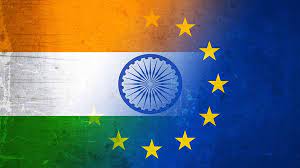Free Courses Sale ends Soon, Get It Now


Free Courses Sale ends Soon, Get It Now



Copyright infringement is not intended
Context: Russia-China ‘no limit’ pact opens doors for India-EU convergence. India and the US are also working on a similar trade and technology council on the lines EU has now set up with India and has with Washington.
More about news:
About EU:
Overview of India EU relations
Political:
Economic:
Climate Change:
Broad-based Trade and Investment Agreement (BTIA)
COVID-19 effects
Security cooperation
Export potential:
https://epaper.thehindu.com/Home/ShareArticle?OrgId=GER9OCD04.1&imageview=0&utm_source=epaper&utm_medium=sharearticle
© 2024 iasgyan. All right reserved